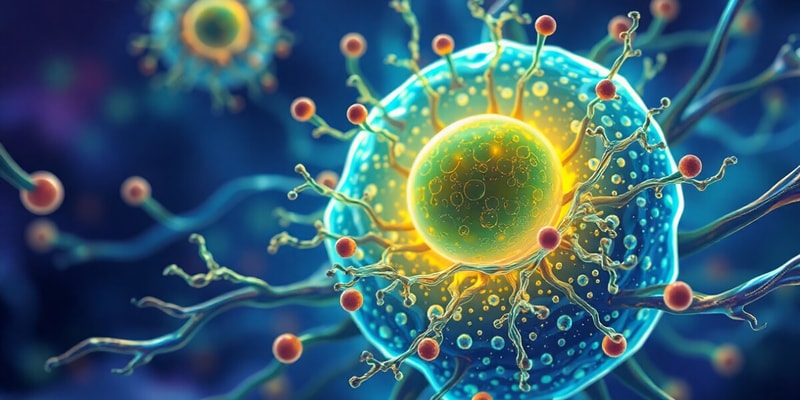Podcast
Questions and Answers
- Stem cells have therapeutic uses in tissue repair and regeneration and drug development, but their use raises ______ concerns related to the destruction of embryos and genetic manipulation.
- Stem cells have therapeutic uses in tissue repair and regeneration and drug development, but their use raises ______ concerns related to the destruction of embryos and genetic manipulation.
ethical
- Eukaryotic cells have a nucleus, membrane-bound organelles such as mitochondria, Golgi apparatus, endoplasmic reticulum, cytoskeleton, and lysosomes, and differ from prokaryotic cells in ______, shape, and method of reproduction.
- Eukaryotic cells have a nucleus, membrane-bound organelles such as mitochondria, Golgi apparatus, endoplasmic reticulum, cytoskeleton, and lysosomes, and differ from prokaryotic cells in ______, shape, and method of reproduction.
size
- The plasma membrane is a selectively permeable barrier composed of a ______ bilayer and proteins.
- The plasma membrane is a selectively permeable barrier composed of a ______ bilayer and proteins.
lipid
Study Notes
Introduction to Cells and Ultrastructure of Prokaryotic and Eukaryotic Cells
-
The cell theory states that all living organisms are made up of one or more cells, the cell is the basic unit of life, and all cells come from preexisting cells.
-
Unicellular organisms perform all basic functions of life, such as metabolism, growth, reproduction, and response to stimuli.
-
Magnification refers to the ratio of the size of an object as it appears in an image to its actual size.
-
Electron microscopes produce higher-resolution images than standard light microscopes due to electrons' shorter wavelength.
-
A large surface area to volume ratio allows for greater exchange of materials between the cell and its environment.
-
Adaptations that increase the ratio of surface area to volume in cells include the presence of cell membrane infoldings, multicellular structures, and cilia or flagella.
-
Emergent properties refer to characteristics or behaviors that arise from the interactions and organization of a system's components.
-
Cell differentiation is the process by which cells in multicellular organisms express some of their genes but not others to carry out specialized functions.
-
Stem cells are unspecialized cells that can differentiate into various specialized cell types, while normal cells are already specialized and can only perform specific functions.
-
There are several sources of stem cells, including embryonic stem cells, adult stem cells, induced pluripotent stem cells, umbilical cord stem cells, and amniotic fluid stem cells.
-
Stem cells have therapeutic uses in tissue repair and regeneration and drug development, but their use raises ethical concerns related to the destruction of embryos and genetic manipulation.
-
Prokaryotic cells reproduce through binary fission and have a cell wall, plasma membrane, cytoplasm, ribosomes, nucleoid, flagella, and pili.
-
Eukaryotic cells have a nucleus, membrane-bound organelles such as mitochondria, Golgi apparatus, endoplasmic reticulum, cytoskeleton, and lysosomes, and differ from prokaryotic cells in size, shape, and method of reproduction.Cell Structure and Membrane Transport
-
Animal cells have microvilli and centrioles, while plant cells have a cell wall, chloroplasts, and a large central vacuole.
-
Extracellular components provide structural support and play a role in cell signaling.
-
The plasma membrane is a selectively permeable barrier composed of a lipid bilayer and proteins.
-
Membrane proteins have functions in transport, cell-cell recognition, and enzymatic activity.
-
Falsification of theories is important in developing models of membrane structure.
-
Diffusion is the movement of molecules from an area of higher concentration to an area of lower concentration, while osmosis is the diffusion of water across a membrane.
-
Red blood cells can swell or shrink depending on the tonicity of the solution they are placed in.
-
Passive transport occurs through simple diffusion and facilitated diffusion, which require no energy input from the cell.
-
Vesicles are used to transport materials within a cell between the rough endoplasmic reticulum, Golgi apparatus, and plasma membrane.
-
Vesicles form at the rough ER, move to the Golgi apparatus for modification and sorting, and then fuse with the plasma membrane for exocytosis or endocytosis.
-
The process of vesicle transport allows for proper delivery of proteins, lipids, and other cellular materials to their intended locations.
-
Understanding cell structure and membrane transport is important for understanding cellular function and disease processes.
Studying That Suits You
Use AI to generate personalized quizzes and flashcards to suit your learning preferences.
Description
Test your knowledge on the fundamental concepts of cell biology with this quiz on Introduction to Cells and Ultrastructure of Prokaryotic and Eukaryotic Cells. From the cell theory to the ultrastructure of prokaryotic and eukaryotic cells, this quiz covers a range of topics, including magnification, surface area to volume ratio, emergent properties, cell differentiation, and stem cells. Additionally, the quiz covers the cell structure, membrane transport, and the role of vesicles in




